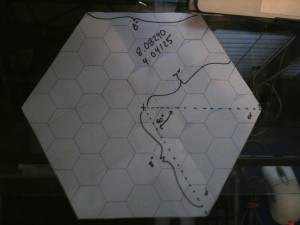I know this post only has a LITTLE to do with BattleTech, but I’m putting it here because it was a BattleTech project that peaked my interest.
As I’m working on my modular table, I’m working on the mathematical anatomy of a hexagon. I’ve noticed several things with my 2″ Hexagon grid:
First thing I did is that I drew lines across my Hex Grid at the angles of the hexagons themselves.
When I put the lines down and made sure they were all “pretty close’, I noticed that of my 2″ hexagons, it was 7 hexes from flat to flat. Then I also noticed for the first time, that a Hexagon is actually 6 equilateral triangles. I also measured the side and it was about 8” I knew this was wrong as I wouldn’t think it would be that easy. So I was ready for some math:
When I split one of the equilateral triangles in half I get a right triangle:
- The Three Angles are 30, 60 and 90 degrees
- One of the sides is 7″ (the long edge along the right triangle).
Knowing what I know of geometry I knew since one of the angles was double that of the other angle, then one side would be exactly double (or half) of the other angle.
There were two ways to do this:
Pythagorean theorem: x squared + one half x squared = 7 squared.
Trig: cos 30 deg = 7in divided by the adjacent (0.866025403784439 = 7 /x | 0.123717914826348 = 1/x || x = 8.08290376865476)
I like the trig way better, as it’s easier with a calculator.
So for a 14″ face to face hex each side will be 8.08290376865476 and the radius of an inscribed circle will also be 8.08290376865476
Fun stuff!
So here’s the anatomy of a hexagon:
So a Hex (by definition) is:
- Six equilateral triangles with their points intersecting at the middle
- A side of a Hex is 0.577350269189626 that of the face-to face width
- the point to point length of a hex is 1.154700538379251 that of the face to face width
- Each hex is angle is 120 degrees
Class is over (for me 😉 )
